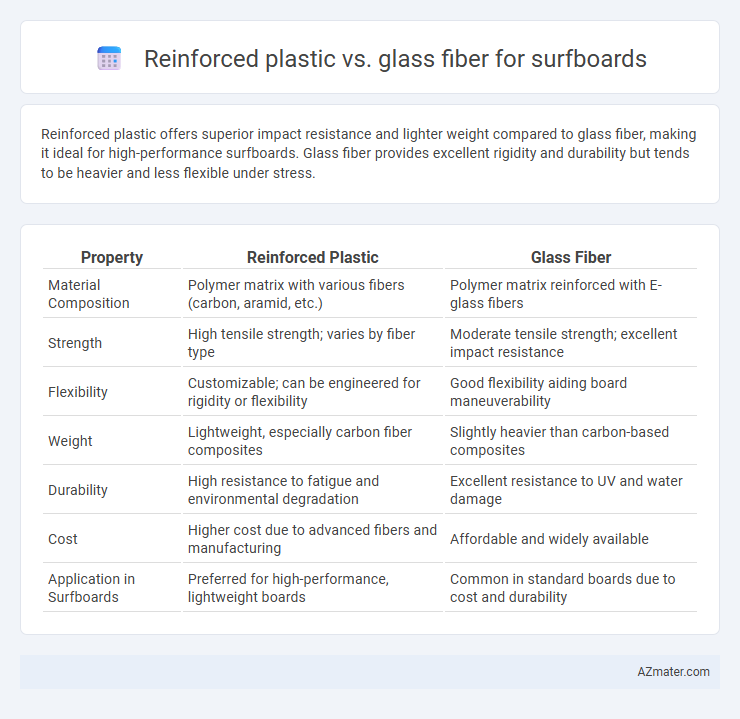Reinforced plastic offers superior impact resistance and lighter weight compared to glass fiber, making it ideal for high-performance surfboards. Glass fiber provides excellent rigidity and durability but tends to be heavier and less flexible under stress.
Table of Comparison
| Property | Reinforced Plastic | Glass Fiber |
|---|---|---|
| Material Composition | Polymer matrix with various fibers (carbon, aramid, etc.) | Polymer matrix reinforced with E-glass fibers |
| Strength | High tensile strength; varies by fiber type | Moderate tensile strength; excellent impact resistance |
| Flexibility | Customizable; can be engineered for rigidity or flexibility | Good flexibility aiding board maneuverability |
| Weight | Lightweight, especially carbon fiber composites | Slightly heavier than carbon-based composites |
| Durability | High resistance to fatigue and environmental degradation | Excellent resistance to UV and water damage |
| Cost | Higher cost due to advanced fibers and manufacturing | Affordable and widely available |
| Application in Surfboards | Preferred for high-performance, lightweight boards | Common in standard boards due to cost and durability |
Introduction to Surfboard Materials
Reinforced plastic surfboards use composites like epoxy or polyester resin combined with fiberglass or carbon fibers to enhance strength and durability. Glass fiber remains the traditional reinforcement material, valued for its balance of weight, flexibility, and cost-effectiveness in surfboard construction. Both materials impact performance, with reinforced plastics offering improved resistance to impact and water absorption compared to purely glass fiber boards.
What is Reinforced Plastic?
Reinforced plastic is a composite material consisting of a polymer matrix embedded with fibers such as glass, carbon, or aramid to enhance strength and durability, commonly used in surfboard construction for superior rigidity and impact resistance. It offers improved flexural properties and weight reduction compared to traditional glass fiber surfboards while maintaining excellent water resistance and longevity. This material allows for more precise shaping and performance customization, making it a popular choice among professional surfers seeking a balance between strength and flexibility.
Overview of Glass Fiber in Surfboards
Glass fiber in surfboards offers superior strength and durability due to its high tensile properties and resistance to impact and abrasion. It provides excellent flexibility and lightweight characteristics, enhancing board performance in various wave conditions. Commonly used in multiple layers, glass fiber reinforces the foam core, ensuring the surfboard maintains structural integrity while optimizing maneuverability and speed.
Strength and Durability Comparison
Reinforced plastic surfboards, often using polyester or epoxy resin combined with fiberglass, exhibit high tensile strength and resistance to impact, making them more durable in rough conditions compared to traditional glass fiber boards. Glass fiber surfboards, while offering good flexibility and lightweight characteristics, tend to be more prone to dings and delamination under repeated stress or heavy impacts. The enhanced resin matrix in reinforced plastic compositions significantly improves overall board longevity and structural integrity, resulting in superior performance for surfers seeking strength and durability.
Flexibility and Performance Differences
Reinforced plastic surfboards offer increased durability but typically lack the flexibility found in glass fiber boards, which provide superior responsiveness and dynamic flex during rides. Glass fiber's natural elasticity enhances performance by allowing the board to bend smoothly under pressure, improving maneuverability and energy return. The choice influences how the surfboard interacts with waves, with glass fiber favored for high-performance surfing and reinforced plastic preferred for rugged, long-lasting use.
Weight and Handling in the Water
Reinforced plastic surfboards typically weigh less than glass fiber boards, enhancing maneuverability and ease of handling in the water. The lighter weight of reinforced plastic allows surfers to perform quicker turns and maintain better control in various wave conditions. Glass fiber surfboards, while durable, tend to be heavier, which can reduce responsiveness and make them less agile compared to their reinforced plastic counterparts.
Cost Considerations: Reinforced Plastic vs Glass Fiber
Reinforced plastic surfboards generally offer a lower upfront cost compared to glass fiber boards due to cheaper raw materials and simplified manufacturing processes. Glass fiber boards, while more expensive initially, provide greater durability and performance, potentially reducing long-term replacement expenses. Choosing between reinforced plastic and glass fiber depends on balancing immediate affordability with the desired lifespan and surfing experience.
Environmental Impact and Sustainability
Reinforced plastic surfboards typically utilize fiberglass and polyester resins, resulting in significant environmental concerns due to non-biodegradable materials and toxic emissions during manufacturing. Glass fiber offers strong durability but often involves energy-intensive production and challenges in recycling, contributing to long-term ecological footprints. Sustainable alternatives like bio-based resins and recycled glass fibers are emerging to reduce marine pollution and carbon emissions in surfboard construction.
Suitability for Different Surfing Styles
Reinforced plastic surfboards offer enhanced durability and flexibility, making them well-suited for beginner and intermediate surfers who require impact resistance and maneuverability in various wave conditions. Glass fiber boards excel in performance due to their lightweight and stiffer structure, preferred by advanced surfers seeking high responsiveness and speed for aggressive, high-performance surfing styles. The choice between reinforced plastic and glass fiber ultimately depends on the rider's skill level and preferred surfing style, with reinforced plastic favoring durability and versatility, while glass fiber emphasizes agility and precision.
Choosing the Right Material for Your Surfboard
Reinforced plastic offers enhanced durability and impact resistance, making it ideal for surfers seeking long-lasting performance. Glass fiber provides superior flexibility and traditional responsiveness, preferred by riders valuing board control and maneuverability. Selecting the right material depends on balancing durability needs with desired board performance and riding style.

Infographic: Reinforced plastic vs Glass fiber for Surfboard
 azmater.com
azmater.com